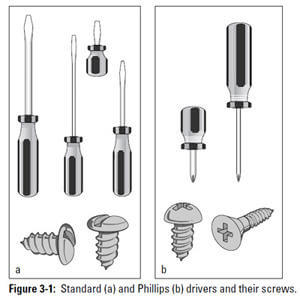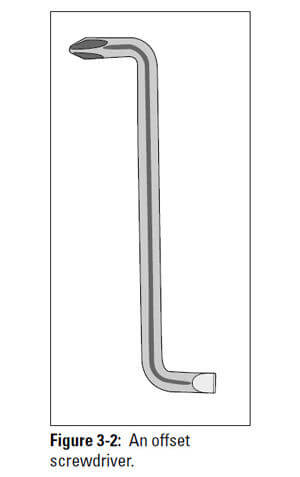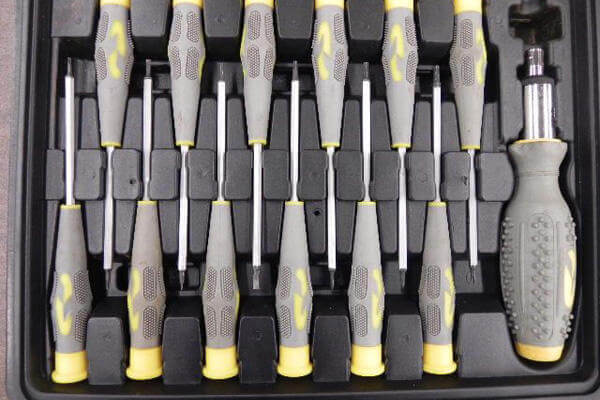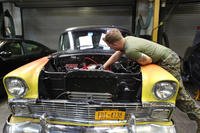Shopping for Tools
Tool prices vary widely, but if you keep your eyes open and know where to go, whom to talk to, and what to look for, you can get a good value at a fair price. Here are some general pointers:
- Shop for tools in a major auto parts chain store, and stick to well-known brands. Poor quality tools can break and cause injuries.
- Watch the newspaper for sales; most chains have them regularly, and you can save a lot of money that way.
- Buy each kind of tool in sets of different sizes rather than buying each size at random. You can save money this way.
- Look for high-grade steel with no rough edges.
- Pick out friendly-looking salespeople and ask them what kinds of tools they buy. Most are auto enthusiasts who are delighted that you're planning to do your own work (and be a future customer), and they're happy to point out the best buys.
Buying everything at once isn't necessary to get started on your car; use the beg, borrow, and steal-from-the-family-toolbox methods if you must. Or, if as you read this chapter you're made painfully aware that you need to buy practically everything, consider prepackaged tool kits. Nearly every major supplier carries an inexpensive basic automotive tool kit that contains everything you need for maintenance and minor repairs. If you're totally tool-poor, such a kit may prove to be the best buy. Just make sure that you're getting good quality tools; it's better to have a couple of tools that work well than to have a large assortment of junk.
While I'm on the subject, empty toolboxes are inexpensive and worth buying. They keep tools clean, in good shape, and, most important, all in one place. Look for a lightweight, plastic toolbox that fits easily into the trunk of your vehicle. Although your tools are useful around the house, it's nice to have them handy if you get stuck away from home.
Screwdrivers
There are two basic types of screwdrivers: standard, or slot, screwdrivers (the most common type) and Phillips screwdrivers. The difference between a standard screwdriver and a Phillips screwdriver is the shape of the head, as shown in Figure 3-1. You use Phillips screwdrivers with Phillips screws and standard screwdrivers with — you guessed it — standard screws.

Offset screwdrivers, which are "S"-shaped and have different-sized tips at each end, also are very handy because they make it easy to get to screws that have little clearance over the head. Offset screwdrivers come in both standard and Phillips styles and some have one of each type of head at either end (see Figure 3-2).

Using the wrong type or size screwdriver can damage the screw, the screwdriver, and even you if your hand slips while you're struggling to use the wrong tool. Always use a screwdriver with a tip that's the same width and type as the head of the screw you're working on.
Because you usually can't use a standard screwdriver on a Phillips screw or vice versa (although there are some exceptions), and because your vehicle is fitted with both types of screws in a variety of sizes, you need several of each type of screwdriver (not just for your vehicle, but for almost anything around the house).
Screwdriver shafts vary in length too, which is useful because a longer shaft provides greater access to "buried" screws that are sunk below the surface of some parts instead of level with them; a shorter shaft gets into tight places more easily. Handles also vary. It's important to have large, easy-to-grip handles to help you loosen tight screws.
You can get all the screwdrivers you need to work on your vehicle for relatively little money. Look for sales on plastic- or rubber-handled screwdrivers in sets of varying sizes. Also available are nice gadgets that contain assorted Phillips and standard screwdriver heads in a single, magnetized ratchet handle. You just pop the right-sized head on the shaft and twist the handle to turn the screwdriver automatically. This magnetized tool also serves as a screwholder.
Screwholders
Screwholders are perfectly marvelous for hanging onto screws that have to fit into tiny places. Instead of holding a screw in place with the fingers of one hand while wielding the screwdriver with your other hand, you simply fit the screw into the screwholder and use the screwholder instead of a screwdriver to insert and tighten the screw. One type of screwholder has a magnet to hold the screw; another (see Figure 3-3) has a little gizmo that grabs the screw when you twist the screwholder. Both are great and work equally well. They come in standard and Phillips versions.

|
The turning of the screw If you find yourself confronted with a screw that's difficult to start unscrewing, try giving it a slight twist in the opposite direction (clockwise), as though you were trying to tighten it. Then loosen it (counterclockwise). If this trick doesn't work, tap the screwdriver on the head with a hammer, which may loosen the screw a bit. If strong-arm tactics don't get you anywhere, try squirting the troublemaker with penetrating oil. (Don't use penetrating oil on a running engine or on any really hot areas because it could ignite.) Remember to keep your temper with difficult screws; otherwise, you risk stripping the threads and turning a fairly simple job of replacing what you've loosened into a hair-puller. |










